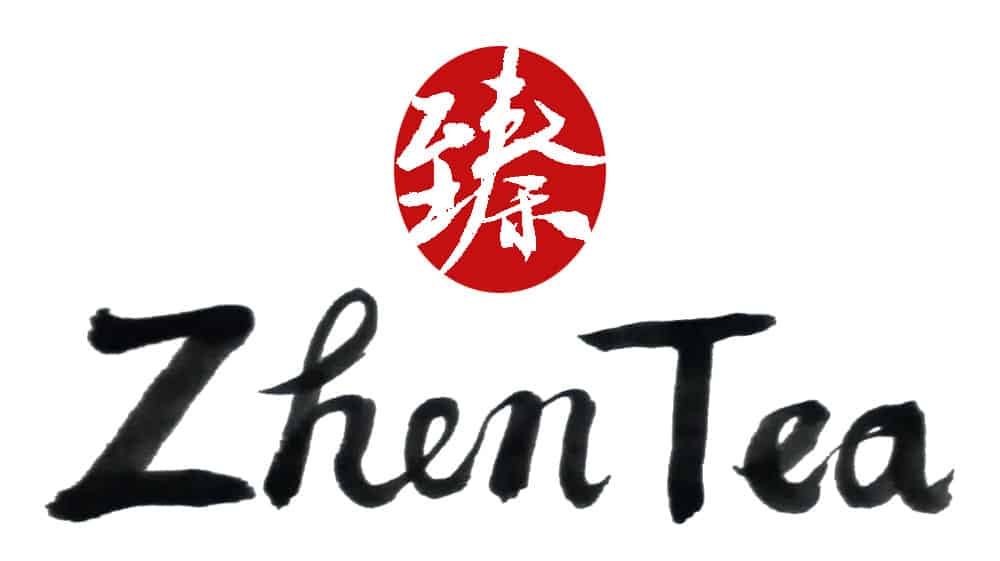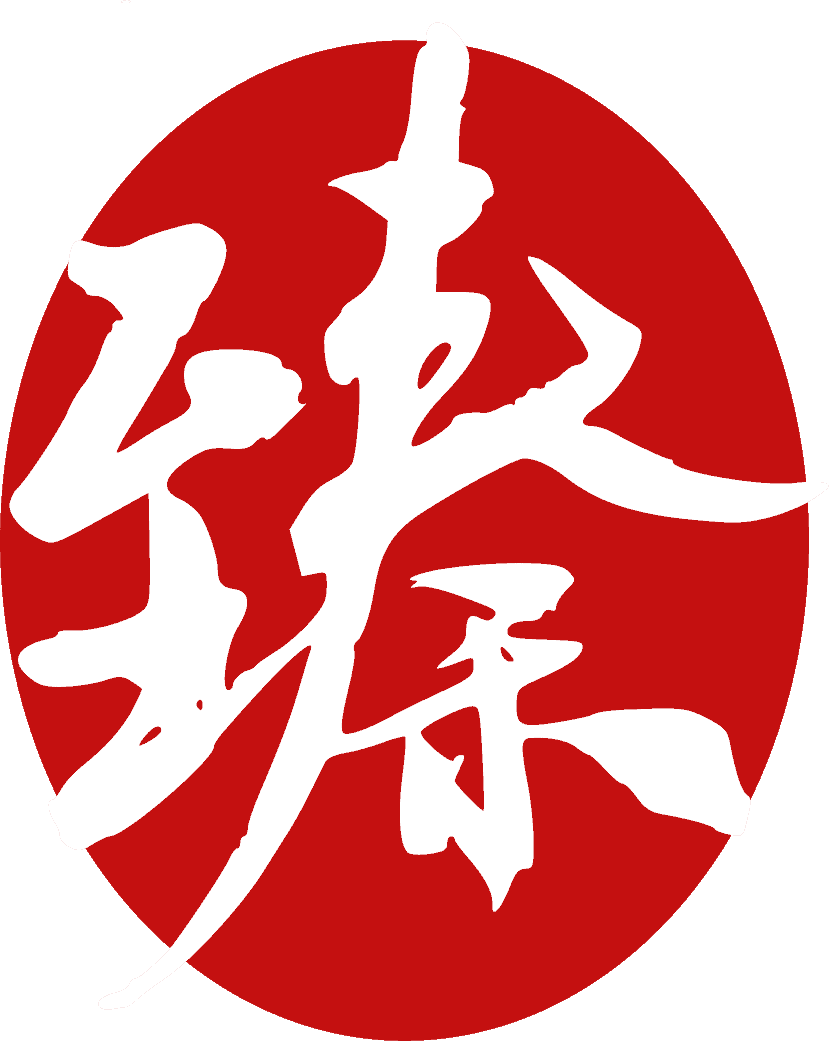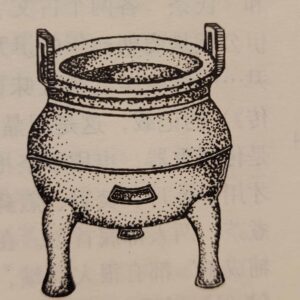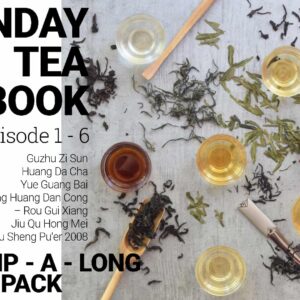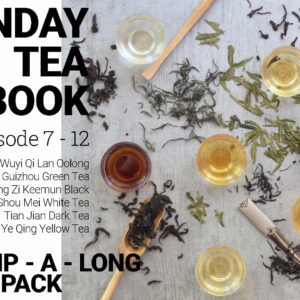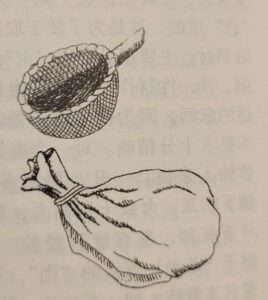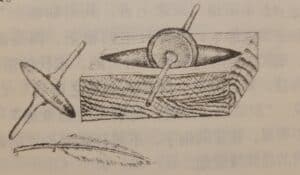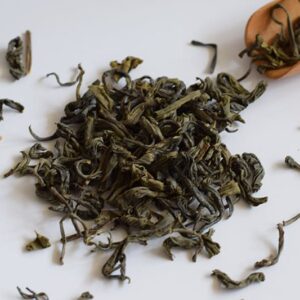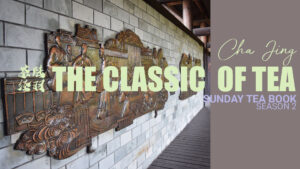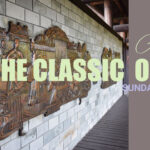Please check out the Sunday Tea Book videos below for additional information about the Classic of Tea.
Chapter 4 – Utensils
Stove (feng lu,风炉), made with iron or brass. The shape looks like ancient tripod cauldrons. Its wall-to-edge ratio is 3:9, and cover the wall with mud. There are 21 characters engraved on the three legs. The inscription on one leg is “water on the top, wind at the bottom, fire in the middle” (kan shang xun xia li yu zhong, 坎上巽下离于中). One legs says “peaceful body, five elements, free of disease” (ti yun wu xing qu bai ji, 体匀五行去百疾). The other leg is incscriptsed “forged on the second year of eliminating rebellion(764 AD)” (sheng tang mie hu ming nian zhu, 圣唐灭胡明年铸).
Sip-a-long with today’s tea or grab enough for the whole season and SAVE!
-
Sale!
The Classic of Tea Sip-a-Long 6 Pack Season 2 Episode 1 – 6
Original price was: $93.00.$69.75Current price is: $69.75. -
Sale!
The Classic of Tea Sip-a-Long 6 Pack Season 2 Episode 7 – 12
Original price was: $53.50.$41.00Current price is: $41.00. -
Wuyi Qi Lan
$16.00 – $59.00
Between the 3 legs on the belly of the stove, there are 3 holes. There is a hole in the bottom. They are for aeration and ash cleaning respectively. There are 6 characters on the belly. On one side is written “yi gong” (伊公), on another side, “geng lu” (羹陆), and the other side is written, “shi cha” (氏茶). Together they form “Yi Yin’s soup, Lu Yu’s tea” (伊公羹,陆羽茶). Inside the stove, there is a mount for fuel, dividing the inside into 3 sections. One part engraves “zhai” (翟), meaning fire animals, and li trigram. One engraves “biao” (彪), meaning wind animals, and xun trigram. The last section engraves “yu” (鱼), meaning water animals, and kan trigram. Xun, li, kan trigrams symbolise wind, fire, and water respectively. Wind facilitates fire, and fire can boil water. That’s the reason to put these three trigrams here. Decorate the body of the stove with plants, landscapes, and patterns. The stove is made of steel or clay. The ashtray is a metal plate with three legs.
Ju (筥), made with bamboo, 36cm (1 chi 2 cun) tall and diameter of 21 cm. Sometimes it’s made into a ju shaped wooden box. It’s made with rattan, woven into a hexagon shape on the top. Smooth out the lid edge and the bottom edge like how it would be done with bamboo box.
Tan zhua (炭檛), a hexagon shapde iron rod, 30cm (1 chi) long, pointy at the end, wider in the middle. At the end of the holding side attached a decorative metal ring. Tan Zhua looks like the wooden rod that the soldiers who guard the Huanghe river use. Tan Zhua can also be hammer or ax shape too.
Sip-a-long with today’s tea or grab enough for the whole season and SAVE!
-
Guizhou Green Tea
$6.00 – $21.00 -
Sale!
The Classic of Tea Sip-a-Long 6 Pack Season 2 Episode 1 – 6
Original price was: $93.00.$69.75Current price is: $69.75. -
Sale!
The Classic of Tea Sip-a-Long 6 Pack Season 2 Episode 7 – 12
Original price was: $53.50.$41.00Current price is: $41.00.
Huo ce (火䇲), also called zhu (筯). It’s chopsticks for fire (huo zhu, 火箸). It’s similar to the common ones, rounded straight rods, 39cm (1 chi 3 cun) long. The top of the chopsticks is flat. no decoration. It’s made with iron or wrought brass.
Fu (鍑), it’s a pot (fu釜 or guo锅). It’s made with raw iron. Raw Iron, also called rushed iron by the blacksmith. This raw iron is usually used for a plow blade. When making fu, cover the inside with mud while the outside with sand. Mud makes the inside smooth, making it easy to wash and maintain. The sand makes the outside rough, better for absorbing the high temperature of the fire. The handle of the pot is square shaped, making the pot easier to be put even. The edge of the pot is wide and extending outward. The belly of the pot is wide so that the heat can concentrate, making the water boil fast which means the tea will boil fast. This results in a rich and better taste of the tea. Pots from Hongzhou are made with porcelain, while Laizhou’s are made with stone. Though porcelain and stone pots look rustic and elegant, they are not strong and robust for long time use. If using silver, it’s very hygienic but too extravagant. Though rustic, elegant, and hygienic are great, it’s better to use iron because it lasts longer.
Jiao chuang (交床), a cross shaped rack with a board on top. Carve out the middle. It’s used to put the pot (a trivet).
Tong (jia 夹), made with fresh young bamboo stick. 36cm (1 chi 2 cun) length. At 3cm (1 cun) area, there’s a node. Cut from the other end to the node in half. And use this tool to roast tea. This kind of bamboo will ooze out juice when in contact with fire. This helps enhance the aroma of the tea. But it’s hard to find if you are not in the woods. Tongs that are made with iron or wrought brass would last long time.
Zhi nang (纸囊), use white and thick double layered shanteng paper to store roasted tea. It avoids loss of the aroma.
Nian (碾), made with orange wood, or pear wood, mulberry wood, paulownia wood, madarin melon berry tree. The grinder is square shape in the outside and round shape in the inside. It’s round on the inside so it’s easier to grind. It’s square on the outside so it’s stable. Inside the nian, there’s a duo (堕) that fits it perfectly without extra space. Duo, looks like a bike wheel without the spokes, only the axle. The axle is 27cm (9 cun) long and 5cm (1 cun 7 fen) wide. Duo has a diameter of 11cm (3 cun 8 fen), 3cm (1 cun) in the center and 1.5cm (half cun) at the edge. The center of the axle is square and the handle is rounded. Fu mo (拂末), made with bird’s feather.
Luo he (罗合), luo is seive (luo shai, 罗筛), he is box (he, 盒). The tea powder after sifted has to be stored in a container with lid. Put ze (则, a measurement tool) in the box. Luo shai, cut the big bamboo open and curve it into a ring shape, and cover it with a thin cloth. The he is made with bamboo or Cunninghamia. Paint it. The he is 9cm (3 cun) tall, lid is 3cm (1 cun) and the bottom is 6cm (2 cun). The diameter is 12cm (4 cun).
Ze (则), it can be shells of mussel, oyster, or clam. It can also be a spoon or a small dust pan made of iron, brass or bamboo. Ze is the measurement tool. Boil about 600ml (1 sheng) water, use 9 cm2 (1 fang cun) tea powder. If prefer lighter taste can reduce the tea amount and vice versa. That’s why it’s called ze.
Shui fang (水方), use zhou (稠,音胄, a tree of Fagaceae family) wood, or wood from sophora tree, Catalpa bungei tree, or Catalpa ovata tree. Use paint to seal the inside and outside seam/crack. Its volume is 600ml (1 sheng).
Lu shui nang (漉水囊), water filter tool, same as what we use daily. The rack is made of raw brass so that when it’s wet, it won’t have mossy or astregent fishy flavour. If use wrought brass, it will turn green after use. If use iron, it wil rust making the water astringent and fishy taste. People who live in the woods also use bamboo and wood, but they don’t last and not convenient for long travel. Therefore, raw brass is the best. Nang (囊, sack?), waived using fresh soft bamboo threads, shaped into a sack. Sow a green thin fabric, decorate it. Then make another green fabric bag as a storage bag for it. Nang has the diameter of 15cm (5 cun), the handle is 4.5cm (1 cun 5 fen).
Ladle (piao 瓢), also known as xi shao (牺杓). It’s a guard (hu lu, 葫芦) cut in half or a carved wood piece. In Du Yu mentioned drinking with guard ladle (zhuo zhi yi hu, “酌之以瓠”) in his poem (chuan fu,荈赋). The guard ladle is piao, wide opening in the front and get narrower as it gets close to the handle. Short handle. In the Yongjia area of Jin Dynasty (307-313AD),Yu Hong from Yuyao (in Zhejiang Province) went to Pubu Shan Mountain to pluck tea. He came across a Taoist priest, and the priest says “I’m Qiu Dan Zi. If you have extra tea in your bottle (ou xi, 瓯牺) one day, hope you can share some with me.” Xi (牺) is wooden ladle, now is commonly made with pear wood.
Bamboo tong (zhu jia, 竹夹), made with peach wood, willow wood, or fan palm wood, persimmon wood. It’s 30cm (1 chi) long, both ends are covered with silver.
Cuo gui (鹾簋), is a container for salt. It’s made of porcelain, 12cm diameter, box shaped, vase shaped or bottle shaped. Jie (揭), made with bamboo, 12.23 (4cun 1 fen) long, 2.7cm (9 fen) wide. It’s a tool for fetching the salt.
Shu yu (熟盂), is used for boiled water, porcelain or pottery, volume of 1200ml (2 sheng).
Bowl (wan, 碗). The best ones are from Yuezhou (越州). Dingzhou, Wuzhou is second. Yuezhou (岳州) also produce great quality bowls, Suzhou and Hongzhou is not as good. Some people think Xingzhou is better than Yuezhou. That’s not true. If the porcelain from Xingzhou is like silver, then the porcelain from Yuezhou is like jade. This is the first point that Xing porcelain is not as good as Yue porcelain. If the Xing porcelain is like snow, then Yue porcelain is like ice. This is second. Xing porcelain is white giving the tea soup a tint of red, while Yue porcelain is celadon which accentuates the greenness of the tea soup. This is the third reason Xing porcelain is not as good as Yue porcelain. Du Yu from Jin Dynasty says in his poem Chuan Fu, when choosing porcelain or pottery, use those that’s from the east (dong ou, 东瓯). Ou (瓯) (as a place name), is Yuezhou. Ou (瓯) (as the tea cup) is also better when it’s from Yuezhou. The edge of ou is not curved, the bottom of ou is gently arched. Its volume is less than 300ml (half sheng). Porcelain from both Yuezhou (越州) and Yuezhou (岳州) are celadon colored. It help accentrate the color and luster of the tea soup. Tea soup has a tint of red. Xingzhou porcelain is white and made tea soup look more red. Suzhou porcelain is yellow, making the tea soup looks purple. Hongzhou porcelain is brown which makes tea soup loks black. None of these are suitable for presenting tea.
Ben (畚), waived using sweet flag plant. It holds 10 bowls. Also can use ju instead. Line the ju with double folded shan paper, making a square shape space to hold 10 bowls.
Zha (札), use palm tree bark, and tightly hold together by dogwood. Or use a chunk of bamboo. Put a bundle of palm tree bark in the bamboo. It looks like a big writing brush.
Di fang (涤方), a container for water after rinse. Made with Catalpa bungei wood. It’s made the same way as shui fang (水方, a kind of square shaped water container). It’s volume is 4800ml (8 sheng).
Zi fang (滓方). It’s for used tea. It’s made the same way as di fang. It’s volume is 3000ml (5 sheng).
Cloth (jin, 巾). A tough cloth of 60cm (2 chi) long. Need 2 of them so that they can be used to wipe different tools interchangeably.
Displaying rack (ju lie, 具列). A bed or rack shaped tool made with wood or bamboo. Despite what material it is made of, it has to be able to be closed and painted deep dark yellow. It’s 120cm (3 chi) long, 60cm (2 chi) wide, and 18cm (6 cun) tall. Ju lie means store and display all the teawares.
Carrying basket (dou lan, 都篮). Dou lan means all the tools are put in this basket. The inner side of the basket is woven with bamboo into triangular hole style. The outside uses two wide bamboo as the vertical lines, and the narrow bamboo thread as the horizontal threads woven through into square hole style. It’s delicate and elegant. It’s 45cm (1 chi 5 cun) tall, 72cm (2 chi 4 cun) long, 60cm (2 chi) wide. The bottom of the basket is 30cm (1 chi) wide and 6cm (2 cun).
